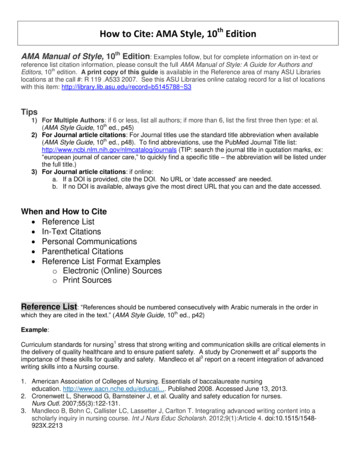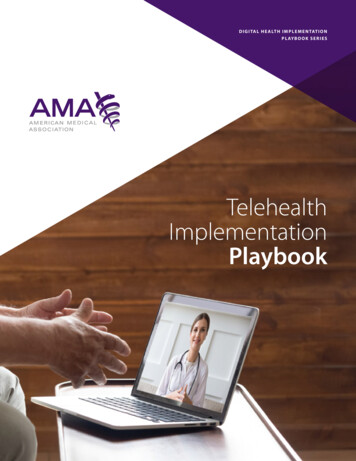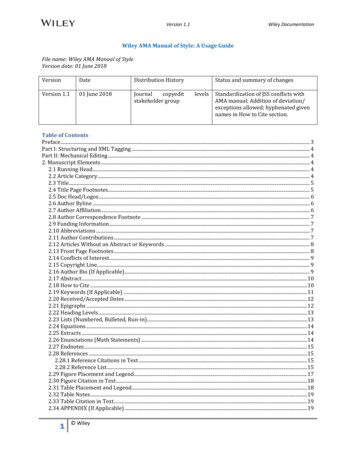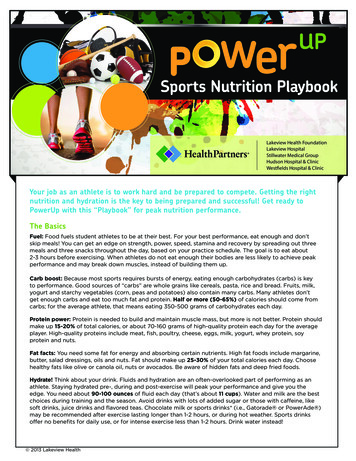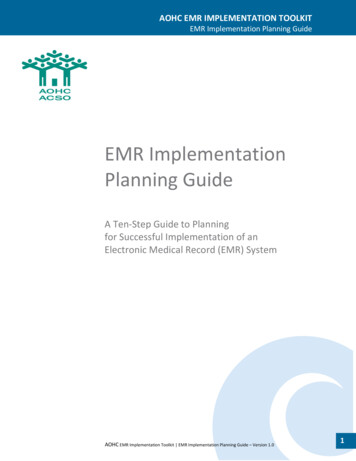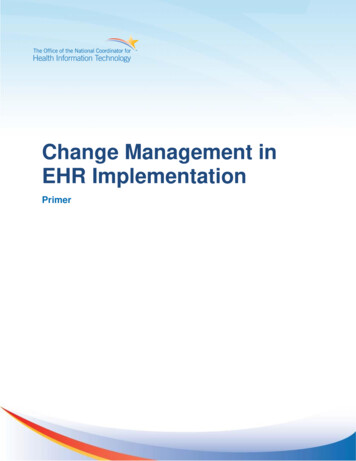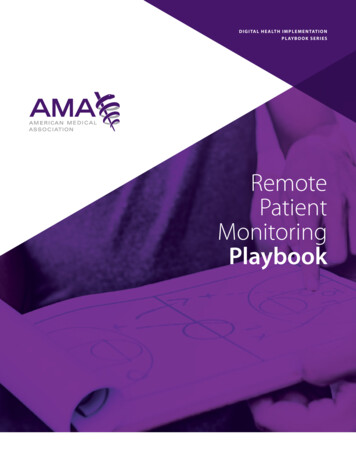
Transcription
D I G I TA L H E A LT H I M P L E M E N TAT I O NP L AY B O O K S E R I E SRemotePatientMonitoringPlaybook
AMERICAN MEDICAL ASSOCIATION REMOTE PATIENT MONITORING PLAYBOOKT H I S A M A R E M OT E PAT I E N T M O N I TO R I N G P L AY B O O Kis for informational purposes only. It is not intended as medical, legal, financial, or consultingadvice, or as a substitute for the advice of a physician, attorney, or other financial or consultingprofessional. It does not imply and is not intended as a promotion or endorsement by the AMAof any third-party organization, product, drug, or service. The opinions expressed by individualsin this Playbook represent the views of the individuals themselves and not those of the AMA.Reimbursement-related information provided by the AMA and contained within this Playbookis for medical coding guidance purposes only. It does not (i) supersede or replace the AMA’sCurrent Procedural Terminology (CPT ) manual (“CPT Manual”) or other coding authority,(ii) constitute clinical advice, (iii) address or dictate payer coverage or reimbursementpolicy, and (iv) substitute for the professional judgment of the practitionerperforming a procedure who remains responsible for correct coding.CPT Copyright 2022 American Medical Association. All rights reserved. AMAand CPT are registered trademarks of the American Medical Association(more information can be found here). 2022 American Medical Associationhttps://www.ama-assn.org/terms-use
Table of ContentsPART 1 / WARM-UP4Introduction to the Digital Health Implementation Playbook Series6Introduction to Digital Health Solutions7What is Remote Patient Monitoring?Remote Patient Monitoring in Practice: Hypertension89The Path to Implementation10PART 2 / PRE-GAME12Step 1 / Identifying a Need14Step 2 / Forming the Team18Step 3 / Defining Success22Step 4 / Evaluating the Vendor26Step 5 / Making the Case30Step 6 / Contracting34PART 3 / GAME TIME—REMOTE PATIENT MONITORING38Step 7 / Designing the Workflow40Step 8 / Preparing the Care Team44Step 9 / Partnering with the Patient48Step 10 / Implementing52Step 11 / Evaluating Success56Step 12 / Scaling60PART 4 / POST-GAME—RESOURCES66
Part 1:Warm-upBefore you embark on your remote patientmonitoring (RPM) implementation, it’simportant to understand what digitalhealth and RPM are and how they areimpacting the world of health care. Thefollowing pages define digital healthand RPM, and explain how to use theresources included in this document.4
5
PA R T 1 / WA R M - U PIntroduction to the Digital HealthImplementation Playbook SeriesDigital tools that enable new methods and modalities to improve health care,enable lifestyle change, and create efficiencies are proliferating quickly. Clinicalintegration of these tools is lacking. We want to change that.At the AMA, we are committedto partnering with physicians tomeet the changing landscapeof health care. Recent research1found that physicians had four keyrequirements for the adoption ofdigital health in practice: Does it work?Will I receive payment?Will I be liable?Will it work in my practice?In support of that pursuit, we havecollaborated2 with physicians andthought leaders to createthis series3.W H AT I S A D I G I TA L H E A LT HI M P L E M E N TAT I O N P L AY B O O K ?Months of research compiled intoa Playbook documenting the mostefficient path to implement newdigital health solutions includingkey steps, best practices, andresources to accelerate and achievedigital health adoption.of digital health and its role inhelping deliver better care. Whetheryou are a physician, a care teammember, health care administrator,or a passionate advocate for theimplementation of digital healthtechnology, if you are looking forguidance to navigate the process andachieve scale, this series of Playbooksis for you.W H Y S H O U L D I U S E T H E P L AY B O O K S ?Implementing digital healthtechnology can be complicatedand time-consuming. On average,it takes hospitals 23 months to gofrom identifying a digital innovationneed to scaling a digital solutionto meet that need.4 The Playbookseries has been designed with inputfrom over 140 physicians, care teammembers, health care administrators,and digital health thought leaders tohelp health care organizations adoptchange faster and more successfully.W H O I S T H I S P L AY B O O K S E R I E S F O R ?W H E N S H O U L D I U S E T H E P L AY B O O KSERIES?This series is intended for thosewho believe in the importanceRefer to this Playbook whenever youare considering the implementation6of a digital health solution. Byadopting these solutions now, yourorganization can improve its abilityto deliver on the Quadruple Aimof Health Care.5W H E R E C A N I U S E T H E P L AY B O O KSERIES?The Playbook is designed for careteams and administrators in medicalpractices of all sizes and areas ofspecialty. We have consulted withsmall private practices and largehealth systems, in rural and urbansettings, with high income andMedicaid-dependent populations.No matter where you are, youcan use this Playbook as a guideto successfully implement digitalhealth solutions in your practice.H O W D O I U S E T H I S P L AY B O O K ?This Playbook is organized into 12key steps to guide you along yourpath to implementation. In additionto this timeline, you will also findresources, checklists, practicespotlight stories, and examples toprovide further guidance alongyour journey.
Introduction toDigital HealthSolutionsDigital Health is the Future.New technologies arefundamentally changing the waypeople interact with health care.Successful implementation ofdigital health technology will beimperative for improving patientoutcomes and ensuring financialstability for health care practices.The landscape of digital healthtechnology is seemingly endlessand spans from internal efficiencysolutions to data managementto population health to patientinteraction tools. You’ve likelybeen exposed to or consideredimplementing a number ofthese solutions. Additionally, theCOVID-19 pandemic has changedthe way care is being delivered andreceived.Despite the increasing prevalenceof digital health, health systemleaders struggle to drive innovation.They are looking for a better andmore efficient path to scaledimplementation, but report thatknowledge gained by otherorganizations and best practices arenot readily available. This Playbookseries is an effort to providewidespread access to institutionalknowledge and best practicescurrently held by experts in thefield.This Playbook series is a livingdocument that will be updated toinclude new content over time. Asthe series evolves, it will providehelpful frameworks and resourcesfor your practice related to specificdigital health solutions.Currently, this Playbookprovides resources for theimplementation of: Remote Patient Monitoring TelehealthIf you are interested inlearning more aboutimplementing digital healthsolutions, you can find otherPlaybooks in the series at:www.ama-assn.org/digitalhealth-playbook7
PA R T 1 / WA R M - U PIntroduction toDigital Health SolutionsWHAT IS REMOTE PATIENT MONITORING?Remote patient monitoring (RPM) is a digital health solution that capturesand records patient physiologic data outside of a traditional health careenvironment.RPM solutions transmit that data tohealth care professionals for review,diagnosis, or clinical management.With this data, the care teamcan monitor chronic conditionsoutside of the traditional healthcare environment and intervene indisease management as necessaryeither in-person or virtually.With seven out of the 10 leadingcauses of death in the UnitedStates and 86% of U.S. healthexpenditures attributed to peoplewith chronic medical or mentalhealth conditions6, finding a solutionis essential to population health andthe fiscal solvency of the U.S. healthcare system. According to Healthboxand their recent Remote Monitoringand Connected Care report, “Remotemonitoring programs present anopportunity to better understand andmanage chronic diseases includingdiabetes, COPD, asthma, and chronicheart failure.” 7RPM is particularly helpful inmanaging these conditions because8it provides visibility into patients’lives outside of their scheduledappointments, which has historicallybeen a barrier to timely and effectivediagnosis and management. Withdata collected over time, care teammembers can manage and treatchronic conditions in a way thatis timely, meaningful, and realisticto the patient’s lifestyle. The datagenerated through RPM can helpfacilitate conversations betweenpatients and physicians around theimpact of disease and response totreatment and provide opportunitiesto intervene more quickly whenhealth conditions worsen.In addition to providing careteams with better, more actionableinformation earlier, RPM has beenpraised for engaging patients intheir own care by providing themaccess to their own data so theycan better understand the impactof their treatment and advocate fortheir medical needs.“I had a young mom, she keptpassing out, saw multiplephysicians, etc., so we did aremote monitoring device. Sureenough, within two months, wepicked up a rhythm that waseasily curable for life. Once wecured the rhythm, she comesback and first thing she saysis, ‘This has changed my life.’Traditional ways for looking forrhythms and all that stuff justdidn’t pick things up, and usingthis newer technology, we wereable to really impact her life.”— D R . R A J S . , C A R D I O LO G I S T(SCL Health)“Because they’re involved,[patients] take a more proactiverole in their health, so they’reable to send info to me, I’m ableto send info back to them. Youknow, for some of them, it’s sort ofa way to remind them of thingsin between visits. So, I think ithas certainly improved some ofthe health outcomes.”— D R . B. , P R AC T I C I N G P H YS I C I A N
REMOTE PATIENT MONITORING IN PRACTICE: HYPERTENSIONA 2018 study published in JAMA demonstrates how remotepatient monitoring has the potential to significantly increaseblood pressure control8.Hypertension affects about 46%of U.S. adults9, has estimated costsexceeding 50 billion annually,and is the most common chroniccondition for which patients seeprimary care physicians.10,11 Sincehypertension often has few orno symptoms, it is commonlyundertreated, leading to severe andlife-threatening complications.A significant number of patientsexperience elevated bloodpressure when in a clinical setting,which can make hypertensionchallenging to accurately diagnose.Poor measurement techniqueand measurement bias can alsocontribute to inaccurate officebased blood pressures. RPM issuited to address these challengesby providing:q Frequent blood pressuremonitoring over longer periodsof time, yielding a moreaccurate assessment of patient’strue blood pressure and risk offuture cardiovascular eventsq Providers’ and patients’ access todaily blood pressures to assessthe need for and response toadjustments in treatmentq RPM can signal effectivenessof treatment and cue earlierchanges in treatmentto get blood pressureunder control fasterWhile remote patient monitoringsystems for hypertension currentlyleverage an at-home, connectedblood pressure cuff, the landscapeis developing rapidly to exploredigestible technology and wearables.The AMA and their partners focuson reducing chronic disease andachieving the vision that everyonewith hypertension in the U.S. willmeet their goal blood pressure. ThisPlaybook will contribute to thatgoal by providing best practicesfor RPM implementation. Wehave collaborated with medicalprofessionals currently using RPMfor hypertension control, as well asmedical professionals using RPMfor other chronic conditions, suchas diabetes and heart disease, todevelop a comprehensive list ofbest practices.9
PA R T 1 / WA R M - U PThe Path toImplementationThe following step-by-stepprocess is intended to guide yourpractice through the implementationof a digital health solution.As this is part of Digital HealthImplementation Playbook Series,the steps to implementation willlikely remain the same throughoutthe series, however each Playbookwill focus on a different digitalhealth modality.The first six steps in Part 2 arefundamental to the implementationof remote patient monitoring.The subsequent six steps in Part3 focus on specific details and theunique considerations relevantto implementing remote patientmonitoring in practice.10While we have displayed thesesteps chronologically, we knowthat the real world is not alwaysstraightforward. Use this process asa guide while understanding that:q The order of steps mayshift based on yourpractice or organizationq Some steps may overlap or maybe executed simultaneouslyq Some steps may take moreor less time than othersq You may need to reiterateor circle back to an earlierstep when expanding yourprogram or if challenges ariseWe recommend readingthrough the Playbook in its entiretybefore embarking on the pathto implementation, so you knowwhat lies ahead. Then, once you’vecommenced the process in practice,refer to each step in Part 2 andPart 3 for best practices, checklistsfor success, and practice spotlightstories to guide you along your way.
TIMELINE OF STEPSPA R T 2IDENTIFYING A NEEDWhat’s the problem?FORMING THE TEAMWho needs to be involvedand when?D E F I N I N G S U CC E S SWhat are we trying to achieve?E VA LUAT I N G T H E V E N D O RWhat’s the right technology?MAKING THE CASEHow do we get political andfinancial buy-in?CO N T R AC T I N GWhat’s our expected timing,budget, and plan with our vendor?PA R T 3D E S I G N I N G T H E W O R K F LO WWhat will need to change tointegrate this technology?P R E PA R I N G T H E C A R E T E A MDoes everyone know what theyneed to do to make this successful?PA R T N E R I N G W I T H T H E PAT I E N TWhat does the patient need?IMPLEMENTINGHow does it work in practice?E VA LUAT I N G S U CC E S SDid it work?SCALINGWhat’s next?11
Part 2:Pre-gameThe following six steps willserve as the general foundationfor implementing remote patientmonitoring in practice and willprepare you to embark on thesteps outlined in Part 3,which will help you plan tooperationalize RPM inyour environment.12
13
PA R T 2 / P R E - G A M ESTEP 1: IDENTIFYING A NEEDStep 1:Identifyinga NeedGround your remote patientmonitoring in a true need.Start by identifying concrete areas where yourpatients may benefit from remote patientmonitoring. Brainstorm a list of your organization’schallenges—where you lose efficiency, whereyour staff encounter pain points, or where patients’health or satisfaction suffers. The focus on needwill help you avoid the temptation to experimentwith new technologies that ultimately won’t resultin tangible improvements to the efficacy of yourorganization or the health and satisfaction ofyour patients. Before adopting RPM, firstidentify what areas your organizationneeds to address or improve, envisionthe outcome you hope to achieve, andthen look for the right technologythat is capable of delivering thatsolution.14
GOALS TO ACCOMPLISH DURING IDENTIFYING A NEEDq Solicit feedback from staff to identify the biggest pain points andopportunities that exist in your organization (Appendix A.1)q Identify areas of opportunity from patients via satisfaction and/or experience survey responses and ensure that responsesare reflective of the diversity within your patient populationq Prioritize your list of pain points and opportunitiesbased on severity of need and fit with the strategicgoals of the organization (Appendix A.2)q Select a problem that, if solved, would have the greatestvalue to your entire organization and patientsq Envision the expected outcome(s) if that problem were addressedq Research digital health solutions capable ofdelivering the desired outcomeWHY IDENTIFYING A NEED IS IMPORTANTPrioritize resources by centering your initiativearound a true organizational need.This practice also: Brings purpose and context to the project Helps crystalize buy-in from key stakeholders Incites long-term stability for the project15
PA R T 2 / P R E - G A M ESTEP 1: IDENTIFYING A NEEDIdentifyinga NeedBEST PRACTICEAVOIDING A MISSTEPLARGE PRACTICE CALLOUTPrioritize areas or usecases identified byfrontline staff that alignwith your organization’sstrategic goals.Be wary of flashynew technology thatpromise to make hugeimprovements.Prioritization can beespecially difficult forlarge organizations.This ensures time and moneyinvested into any newimplementation will delivermaximum value throughout theentire organization.16The newest technology can bevery compelling. To avoid wastingtime solving a problem that youdon’t really have, take the time todo your due diligence and makesure it is a good fit for your needs.It is difficult when key decisionmakers may not regularlyinteract with front-line staff. Seekfeedback from care teams toavoid misalignment between theorganization’s strategic prioritiesand the day-to-day needs of staffand patients.
QUICK TIPLook to yournetwork.Seek out colleagueswithin or at practicessimilar to yours whohave previouslycounseled or executedthe implementationof RPM. Foster opencommunication withthese advisors. If you areaffiliated with anotherpractice or healthsystem, explore howthey might supportyour implementationwith existing programsand/or technology.Throughout theimplementation process,rely on their experienceand advice as you runinto challenges.PracticeSpotlightEngage end users to generate buy-in.Many health organizations want to implement meaningfulimprovements but struggle to prioritize which initiatives to pursuefirst. In order to better align strategic and implementation goals,some organizations hold annual staff hackathons, competitions, oracceleration programs. These organizations encourage their staffto submit day-to-day pain points, challenges, or opportunities.Administrators and executives evaluate these submissions todetermine which areas cause the most pain, and therefore, are mostin need of a solution. By sourcing priorities from the bottom up, theseorganizations tend to better understand their needs and foster moreengagement among their staff. Most importantly, these organizationsmake more informed decisions about which initiatives to prioritizebased on the real needs of their staff and patients.— N I C K D O U G H E R T Y, M A N AG I N G D I R E C TO R , M A S S C H A L L E N G EH E A LT H T E C H17
PA R T 2 / P R E - G A M ESTEP 2: FORMING THE TEAMStep 2:Formingthe TeamThe success of any implementationdepends on engaging the right people.Although one person can be accountable fordriving the process forward, the process itself is agroup effort. While you won’t need to directlyengage all the teams right away, it’s helpfulto identify who will be on which teamsand consider when and how differentplayers will be involved. (AppendixB.3) Consider organizing your keystakeholders into four teams:Core, Leadership, Advisory, andImplementation based on thecriteria and responsibilitiesoutlined in Appendix B.1.18
GOALS TO ACCOMPLISHDURING FORMING THE TEAMq Identify the key members of yourCore, Leadership, Advisory, andImplementation teams (Appendix B.2)q Outline and communicate theresponsibilities and time commitmentrequired of each team memberq Set up regular meetings with your Core teamq Solicit input from your Implementation teamWHY FORMING THE TEAMIS IMPORTANTHaving the right peopleinvolved upfrontprovides diverseperspectives.These different viewpoints arecritical to the development,selection, and implementation ofRPM, as they help to: Anticipate barriers from allangles Facilitate buy-in Minimize workflow disruptionduring implementationq Set key checkpoints with the Advisory teamq Pre-seed your program intent with keymembers of your Leadership team19
PA R T 2 / P R E - G A M ESTEP 2: FORMING THE TEAMForming the TeamBEST PRACTICEKeep the enduser in mind.The foundation of your implementation should beinformed by the people you are designing for, so thesolution is tailored to suit their needs. Consider whowill be most impacted by the new technology—including staff and patients—and solicit feedbackearly on. Or, ask representatives for these individualsto sit on the Advisory or Core teams so you cankeep their needs top of mind throughout theimplementation process. Successful RPM will relyon patient engagement, so talk to a diverse set ofpatients to ensure equitable access to the program.20AVOIDING A MISSTEPCarefully considerwho needs to be at the table.It’s possible to have too many players involved, whichcould slow down the process. Alternatively, missing akey person or role during the planning stages can resultin rework or difficulties with developing buy-in.
“If you don’t have the right people involved upfront, you’ll face pushback down the road.”— D R . K AT I E R I C H A R D S O N , H E A LT H C A R E I N N O VAT I O N L E A D E R ,CO LO R A D O P E R M A N E N T E M E D I C A L G R O U PPracticeSpotlightQUICK TIPPre-seed yourimplementationidea with theLeadershipteam.Use standing meetingsor casual conversationsto keep Leadership teammembers updated onyour program rather thankeep it a secret. Shareyour intent and provideinitial exposure to yourimplementation beforeseeking official approvalto secure high-levelsponsorship and increasebuy-in potential.In many organizations, the implementation ofnew technology is set by upper management.For instance, when Sarah Ortiz, a health care administrator, wasinterested in using a different remote monitoring system, shediscovered that a group consisting of a senior director, senior projectmanager, and one physician solely determined which technologieswere used across all clinics in her organization. As a result, practicemanagers often had to backtrack and meet with the care teams todiscuss the project, scope, roles, and importance of teamwork andhost Q&A sessions with vendor representatives. To avoid a great dealof inefficiency, she recommended that the individuals responsiblefor selecting new technology engage their end users early on forperspective and incorporate their feedback prior to implementation.— S A R A H O R T I Z , H E A LT H C A R E A D M I N I S T R ATO R21
PA R T 2 / P R E - G A M ESTEP 3: DEFINING SUCCESSStep 3:DefiningSuccessDefine what success looks like early.Once you’re aligned with your Core team onan overall vision for success, use this phase toset specific short- and long-term goals withmeasurable metrics metrics using the AMA Returnon Health framework (Appendix E.3) and a processfor tracking your progress to guide your teamalong the way.22
GOALS TO ACCOMPLISHDURING DEFINING SUCCESSq Research the the various ways RPMcan deliver value for your practiceor organization (Appendix E.3)q Identify 3–5 goals that are most importantfor your entire practice or organizationq Identify which metrics are most appropriatefor assessing progress toward these goalsq Ensure each goal is S.M.A.R.T. (Appendix C.2)q Set up a process or system to collect dataand track progress against the goals aboveq Establish specific checkpoints to collect dataq Set clear endpoint criteria to re-evaluateas needed or to scale the programq Plan for how and when you’ll establishbaseline metrics as a comparisonpoint for your program’s successWHY DEFINING SUCCESSIS IMPORTANTEnvisioning successbrings clarity to the goalyou are trying to achieve.This helps: Identify the right vendors Rally the team around acommon goal Bring rigor to tracking metrics23
PA R T 2 / P R E - G A M ESTEP 3: DEFINING SUCCESSDefining SuccessBEST PRACTICEAlign your goals to theQuadruple Aim of Health Care,inclusive of health equity.By focusing on health outcomes, improving thepatient experience, reducing cost and/or increasingprovider satisfaction, you will inevitably impact theend user, care team or patient, in a positive way. Thesegoals are also more likely to align with the strategicimperatives of your organization which will be anadvantage when seeking approval and resources laterin the process. (Appendix C.1)QUICK TIPExplore how digitalhealth solutions fit intogovernment programs.24AVOIDING A MISSTEPDon’t skip this step!Failing to establish a clear vision for successand a way to measure progress can lead to confusion,the need to rework, and frustration, which canultimately jeopardize the fate of your implementation.See how digital health solutions (i.e., remote patientmonitoring) could help your practice or organization meetthe participation requirements for programs such as theQuality Payment Program (QPP), Merit-based IncentivePayment System (MIPS), and/or Alternative PaymentModels (APMs).
“What’s the destination? Where am I headed? Implementation isabout picking your destination and knowing where you’re goingand then working your way backwards on how to get there.”— D R . R A N D A L L W I L L I A M S , C A R D I O LO G I S T,D I G I TA L H E A LT H F O U N D AT I O NPracticeSpotlightAmidst the many considerations associated with theimplementation of digital health—patient privacy, clinicalworkflow, financial viability, etc.—it’s tempting to approach onestep at a time, while neglecting to consider the larger picture.When executing a digital health solution in the treatment of diabetes and hypertension, the implementation teamat Froedtert & Medical College of Wisconsin knew it was important to envision what success looked like upfront.Otherwise, they risked being derailed by several items, including how quickly to react to patient shared data, how todesign and coordinate cross team workflows, as well as how to demonstrate the value of using the tool to patients.As a result of beginning with the end in mind, they now have promising data to demonstrate the benefit of digitalsolutions, which is encouraging patients and the organization to think beyond current care delivery models in favorof a more digitally enabled, patient-centric approach.— I M P L E M E N TAT I O N T E A M , F R O E DT E R T & M E D I C A L CO L L E G E O F W I S CO N S I N25
PA R T 2 / P R E - G A M ES T E P 4 : E VA LUAT I N G T H E V E N D O RStep 4:Evaluatingthe VendorEvaluate possible vendors across keycriteria that will enable your goals.Go into the process with the intent of findingsomeone who will be a long-term partner andnot just someone to execute a transaction. Selecta shortlist of quality RPM products/vendors byspeaking with organizations or practices similarto yours. Alternatively, attending health caretechnology conferences like HIMSS (andlocal HIMSS chapters), HLTH, or RockHealth; collaborating with a health careaccelerator or incubator; or leveragingthe AMA’s Physician InnovationNetwork12 to connect with one of1,500 companies, can exposeyou to possible vendors andpractical solutions.26
GOALS TO ACCOMPLISH DURINGEVALUATING THE VENDORWHY EVALUATING THEVENDOR IS IMPORTANTq Research potential vendorsSelect a vendor who isworthy of a long-termpartnership.q Build a Request for Proposal (RFP), clearlyoutlining the goals you identified in Step 3q Send RFPs to vendors that mostclosely align to your goalsq Review RFP responses alongsidekey representatives from theCore and Advisory teamsThis ensures you will have: An expert resource always onhand in challenging situations Support throughout theimplementation process, fromstart to finish (and beyond) A partner who is equallymotivated as you to achieve asuccessful outcomeq Ask for case studies and referralsq Schedule live vendor demos withselect members of the Core, Advisoryand Implementation teamsq Evaluate vendors across six criticalfactors: Business, Information Technology,Security, Usability, Customer Service, andClinical Validation (Appendix D.1)q Narrow your options to one or two preferredvendors to include in your pitch to leadership27
PA R T 2 / P R E - G A M ES T E P 4 : E VA LUAT I N G T H E V E N D O REvaluating the VendorBEST PRACTICEEvaluate vendors across six key variables to find your best partner.(Appendix D.2) If you’re struggling to identify a vendor that’s right for you, consider engagingexternal resources, such as as your state or specialty society, the Medical Group ManagementAssociation (MGMA), or the Xcertia mHealth App Guidelines, for support. Remember toincorporate legal feedback and security standards to make sure risk and liability is properlyassessed (Appendix E.2) and reference the AMA’s Privacy Principles.28BUSINESS:I N F O R M AT I O N T E C H N O LO G Y:U S A B I L I T Y: Organizational overview– tenure, funding source,financial stability, affiliations,notable customers, etc. Impact to program ROI—product cost, business model,reimbursement rates, risksharing, support paymentprogram participation, etc. Commitment toorganizational diversity,equity, and inclusion Ability to integrate withyour current IT landscape,particularly your EHR system Cost, process, and timelineassociated with integrationand product updates Ensure the data elementsof most importance to yourclinicians and patients canbe captured13 User experience of deviceand interface for patientsand care team members Patient and care teamengagement metrics Ability to engage with andencourage participationfrom patients Degree to which thistechnology/vendor will reducedisruption to existing workflow Diverse users considered inthe development and designof the technology and userexperienceC L I N I C A L VA L I D AT I O N :S E C U R I T Y: ( A P P E N D I X D. 3 )C U S TO M E R S E R V I C E : Documented clinicaloutcomes Published peer-reviewedresearch Product and outcomesresearch includespatients from historicallymarginalized andminoritized populations HIPAA compliance andprocess for ensuringprotection of confidentialpatient information Liability and processfor managing potentialsecurity breaches Level of support availableto practice during and afterimplementation—stafftraining, patient education,project management, dataanalysis and insights, etc. Degree of technical supportavai
digital health solutions including key steps, best practices, and resources to accelerate and achieve digital health adoption. WHO IS THIS PLAYBOOK FOR? This Playbook is intended for those who believe in the importance of digital health and its role in helping deli
